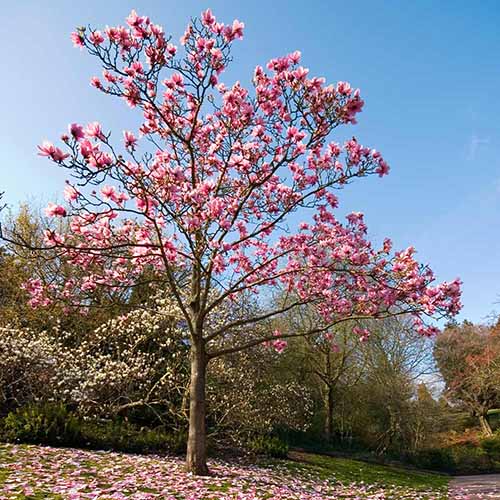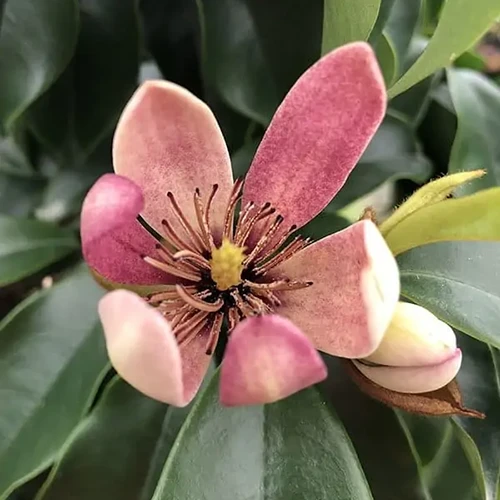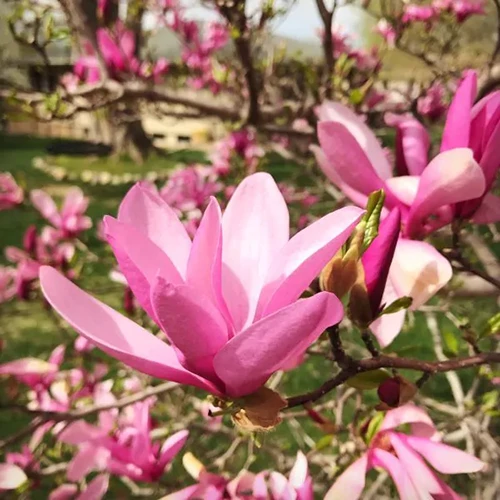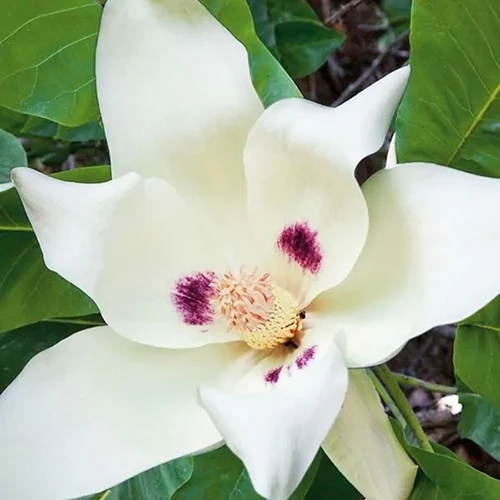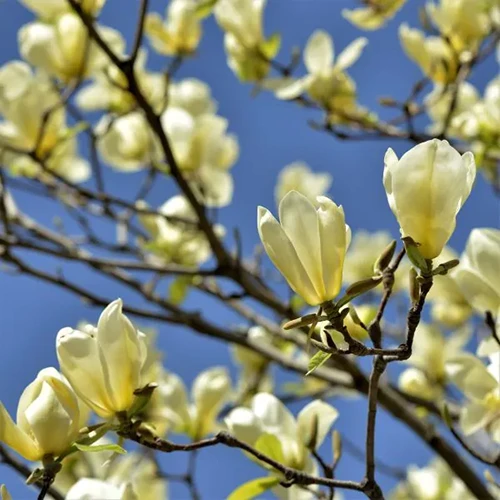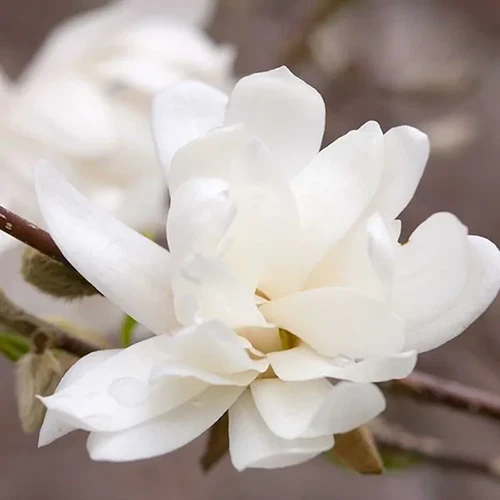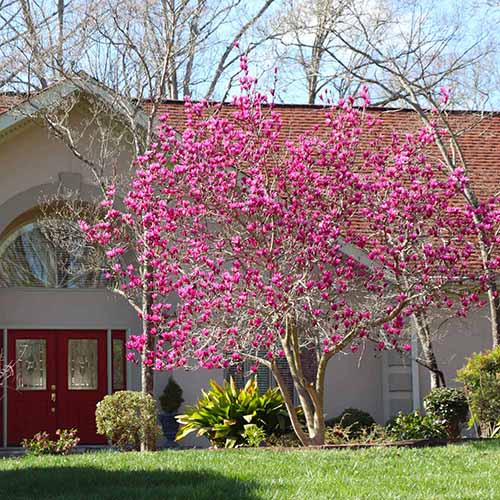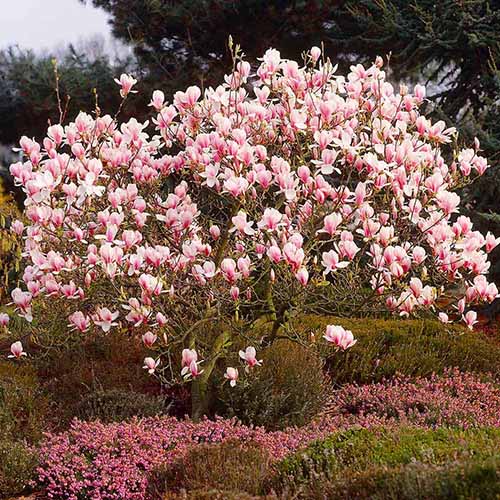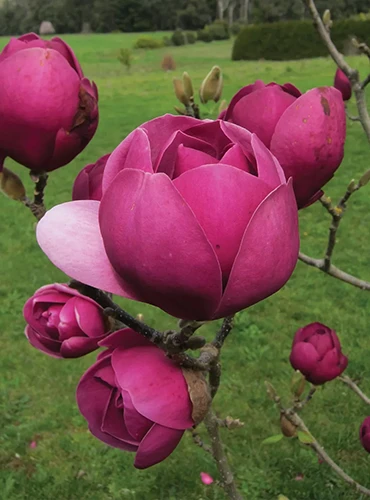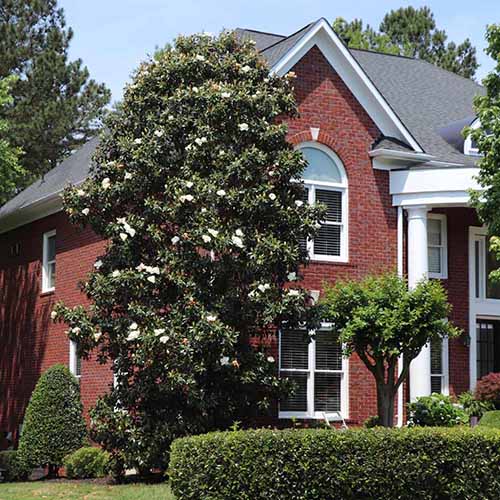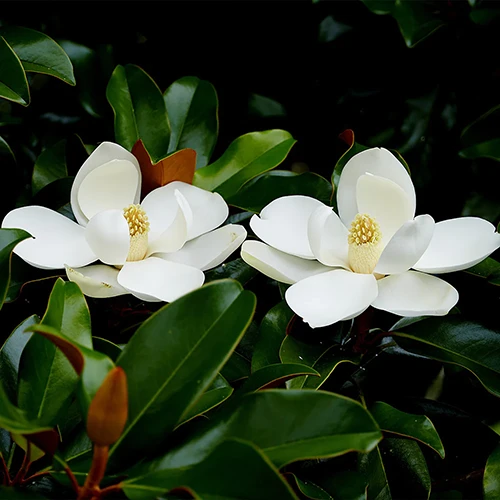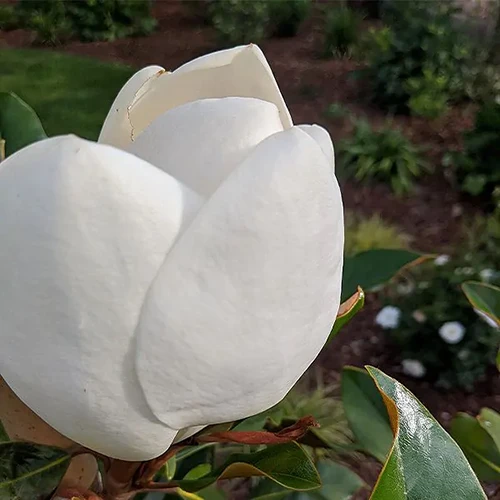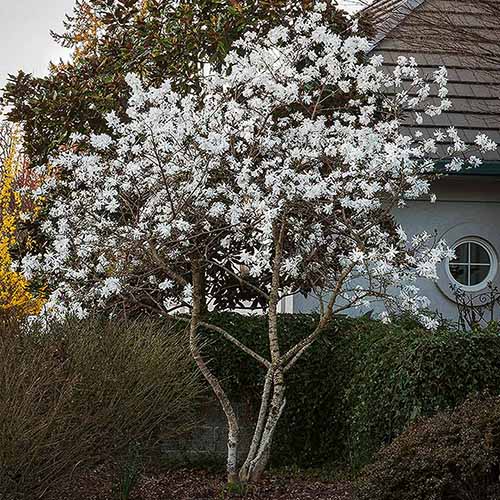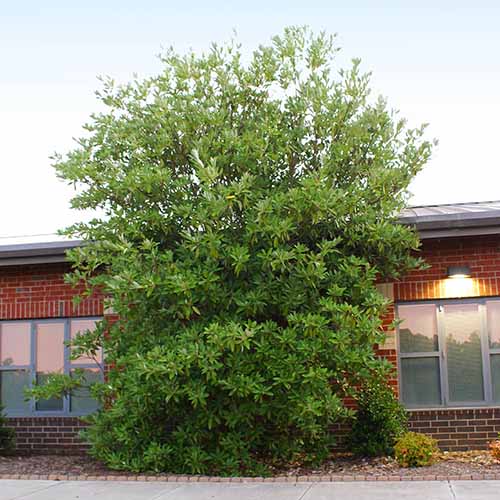There are so many magnolias to choose from. Not only are there hundreds of species, dozens of them are common in cultivation.
Then there are the many, many cultivars and hybrids. Growing magnolias isn’t hard, but choosing one to grow sure can be!

We link to vendors to help you find relevant products. If you buy from one of our links, we may earn a commission.
The first consideration when selecting a tree is your location.
Know your USDA Hardiness Zone and pick a tree that will do well in that area. It won’t do if you fall in love with a particular hybrid only to find that it can’t survive your winters.
Then, it’s all about narrowing down the size and color you want. Don’t panic, this list will help with that.
These are 23 of the best options out there, including excellent species, hybrids, and cultivars of all sizes, colors, and temperature tolerances.
Here are the trees and shrubs that we’ll go over:
You can’t go wrong with any of the options on this list – unless they’re wrong for your climate, of course.
But each one is more eye-catching and elegant than the last. Let’s get to know these magnificent magnolias!
1. Anise
Willow-leafed or anise magnolia (M. salicifolia) is native to Japan and is only for those lucky souls in Zones 6 to 9.
The large blossoms have six tepals (what we usually call petals), and each flower can grow up to six inches across.
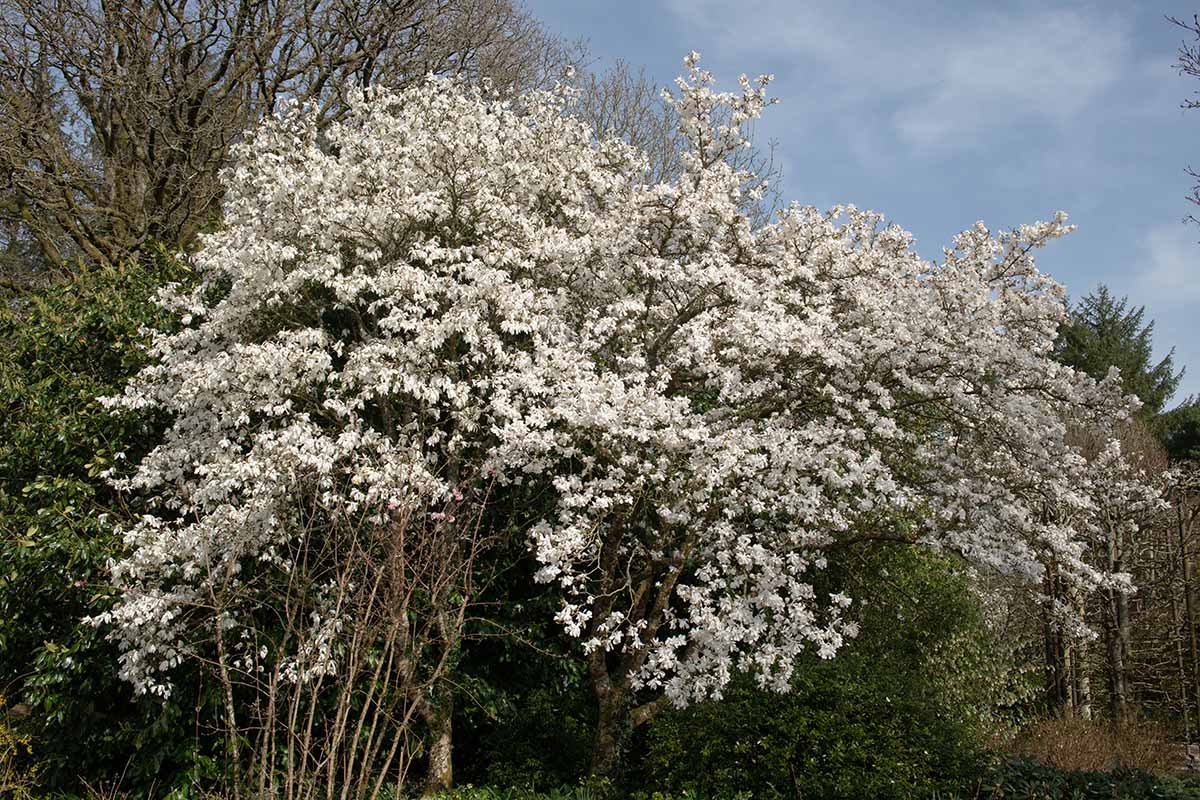
Most cultivars are pure, elegant white, but a few have hints of blush at the base of each tepal. And the blossoms show up before the leaves, which means you can enjoy an early-season display.
Speaking of foliage, not all magnolias are beloved for their leaves, but the ones on this tree emerge in the spring in bright copper orange before transitioning to medium green with gray undersides.
The gray offers up a beautiful contrast as the trees rustle in the breeze. In the fall, they turn golden yellow.
While the species is lovely, it has been the foundation for many, many exceptional hybrids as well.
‘Wada’s Memory’ is one of the most noteworthy hybrids.
It was discovered at the University of Washington Arboretum in a grouping of seedlings sent over by K. Wada of Yokohama, Japan.
If you’re a fan of magnolias, then you know him as a respected exporter of magnolias.
Nature Hills Nursery carries live plants if you’re interested in this worthwhile option.
The species has a pyramidal shape that matures over 10 years or so to 25 feet tall. It has a compact growth habit and thrives in Zones 5 to 8.
And yes, if you’re wondering, this species does have a distinctly anise-like scent in the leaves, bark, and flowers.
2. Ann
‘Ann’ is excellent for people who have a smaller area, but still want to enjoy the full display of a magnolia.
This shrub-like tree is a cross between M. liliiflora ‘Nigra’ and M. stellata ‘Rosea.’ and it is extremely floriferous.

It was bred in the mid-1950s at the US National Arboretum in Washington, DC by plant geneticist Francis de Vos and horticulturist William Kosaras as part of the Little Girls series to be small but late maturing.
The goal was to breed petite plants that were just as beautiful as their parents but in a smaller package. On top of that, they hoped to breed bushes that would flower a week later than other magnolias in order to avoid the late blossom-ruining frosts.
In addition to ‘Ann,’ which is the most successful of the series, you’ll also find ‘Betty,’ ‘Jane,’ ‘Judy,’ ‘Pinkie,’ ‘Randy,’ ‘Ricki,’ and ‘Susan.’
The flowers on ‘Ann’ are huge, with up to 10 tepals per blossom, and each reddish-purple tepal reaches up to three inches long.
If you’re looking for a compact tree for Zones 4 to 7 that doesn’t shirk its flowering duties, grab a live three- to four-foot ‘Ann’ sapling at Fast Growing Trees.
3. Ashe’s
Ashe’s magnolia (M. ashei) is one of those plants that gives you double the reward when you decide to plant it.
It’s positively appealing with heavily-scented white blossoms kissed with bright fuchsia centers, so you’re rewarded with an elegant display. But it’s also endangered in the wild.

This tree only grows indigenously in the wetlands of Florida, and it can be a challenge to find in nurseries.
So when you plant one, you’re also rewarded with the knowledge that you’re helping to promote biodiversity and save an endangered species.
You might see it classified as M. macrophylla var. ashei, and if you compare a bigleaf with an Ashe’s you can definitely detect a resemblance.
Whether it’s a bigleaf or its own species, it’s worth having around, assuming you live in Zones 6 to 9.
4. Banana Shrub
Sure, the closed flowers of the banana shrub (M. figo) can sort of resemble a banana, and they certainly smell like one, but I think this magnolia deserves a better name.
Something that reflects its creamy yellow flowers fringed with magenta…

Maybe we should call it the sunset magnolia? Should we start a petition? Okay, maybe naming plants isn’t my thing.
You can also find cultivars and hybrids with blush or ruby petals if yellow isn’t your favorite color.
If you live in Zones 7 to 10 and you love the scent of ripe cantaloupe or banana, this is the magnolia for you.
Plants By Mail carries the hybrid Stellar Ruby™, a cultivar with pink blossoms.
Bred by noted magnolia breeder Bill Smith, it’s a cross between M. figo var. skinneriana and M. figo var. Crassipes.
5. Betty
Pretty, itty-bitty ‘Betty’ has a round growth habit at 15 feet tall and wide.
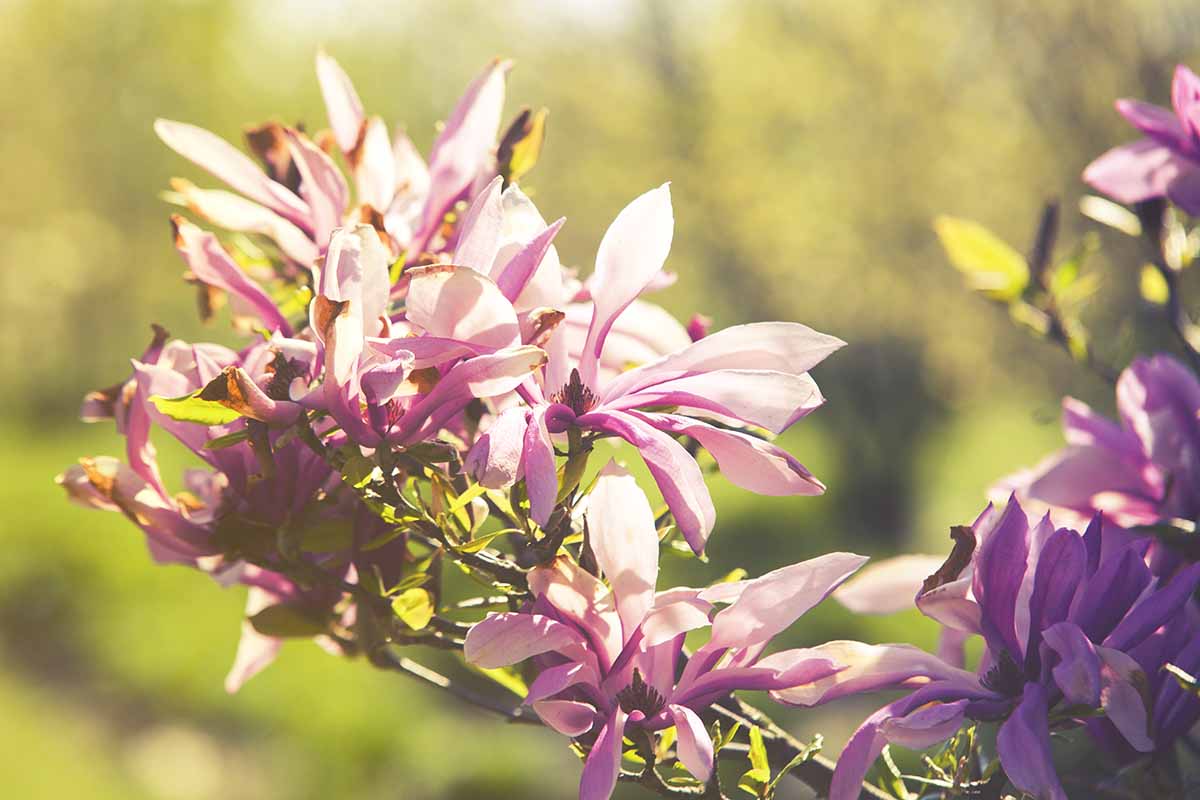
The tepals are vibrant reddish-purple on the outside and white on the inside.
Part of the same Little Girl series as ‘Ann,’ it blooms later in the year than some other types, so it’s less prone to damage from late frost.
It’s a cross between M. liliiflora ‘Nigra’ and M. stellata ‘Rosea,’ with the best characteristics of both, and growers might be able to expect repeat blooming in the summer.
If you’re looking for a big display in a compact package for Zones 4 to 8, Nature Hills Nursery has shrubby ‘Betty’ in #1 or #3 containers.
6. Bigleaf
True to its name, bigleaf magnolia (M. macrophylla) has larger leaves than any other variety.
Not only that – this species has the largest simple leaves of any deciduous tree in all of North America. They’re big, all right!
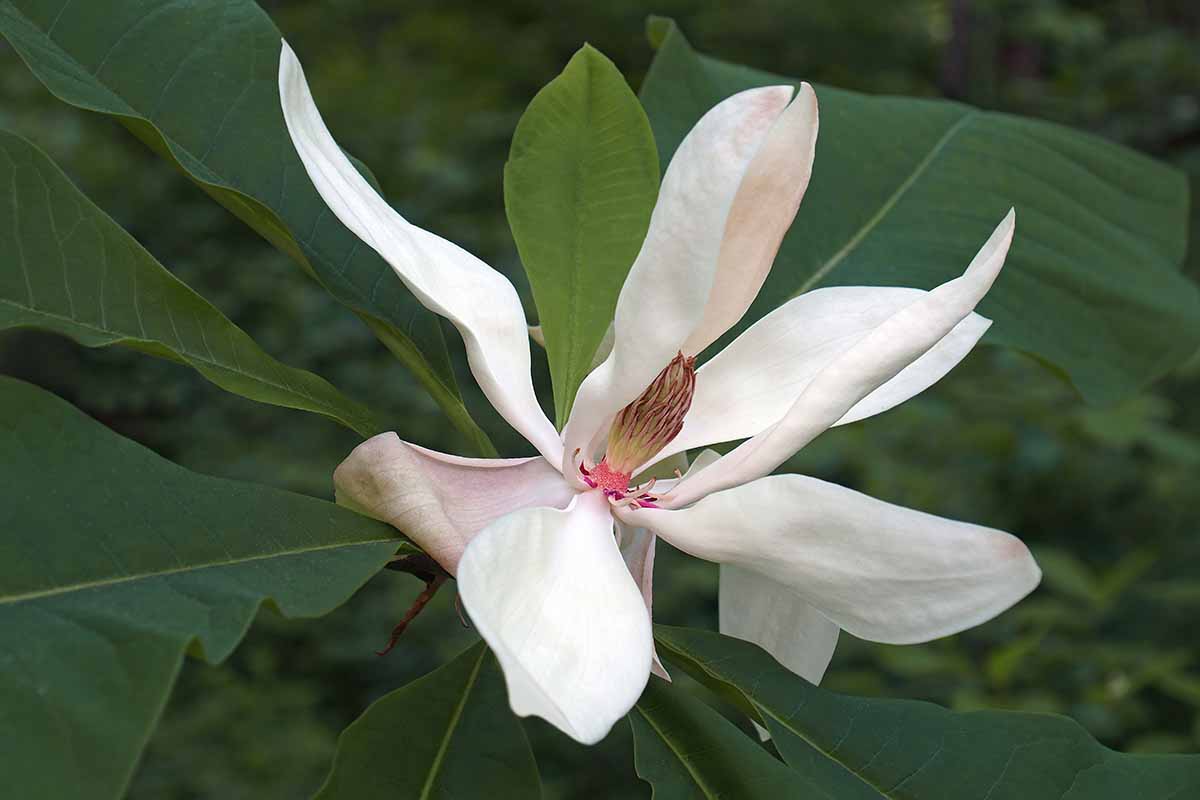
But let’s talk about flowers. Are they proportionally as large? Yep! These also have the largest flowers of any North American indigenous tree.
It’s not all about size, though. The 10-inch ivory flowers are elegant and can be completely white, or they might have a purple-red splotch on the center of each petal.
The trees have a pyramidal form and can grow to be up to 40 feet tall. While the species plants are gorgeous, there are many excellent cultivars and hybrids as well.
‘Purple Spotted’ has dramatic purple blotches on the petals, and ‘Palmberg’ has even larger flowers, up to a foot across, if you can believe it.
Most do well in Zones 5 to 8, but be sure to check the specifics for whatever cultivar you’re considering.
If you want to put on a big show, pick up a live plant at Nature Hills Nursery.
7. Butterflies
Yellow magnolias aren’t that common and yellow types that don’t fade are even more difficult to find.

‘Butterflies’ is a hybrid cross between M. acuminata and M. denudata with a pyramidal growth habit that can reach up to 20 feet high.
The flowers grow in a cup shape and can be as large as five inches across. They tend to emerge all at once and last for just over a week before dropping to the ground.
This makes cleanup intense but it happens all at once. The leaves won’t emerge until all of the flowers have fallen.
Nature Hills Nursery can give you butterflies in your stomach. They have #2 and #5 containers of ‘Butterflies’ so you can bring the magic to your garden if you live in Zones 5 to 9.
8. Cucumber
If you thought you lived somewhere too cold for magnolias, never fear: cucumber magnolia is here. If you need a magnolia that can dominate your yard, this species has you covered, too. It can grow nearly 100 feet tall.
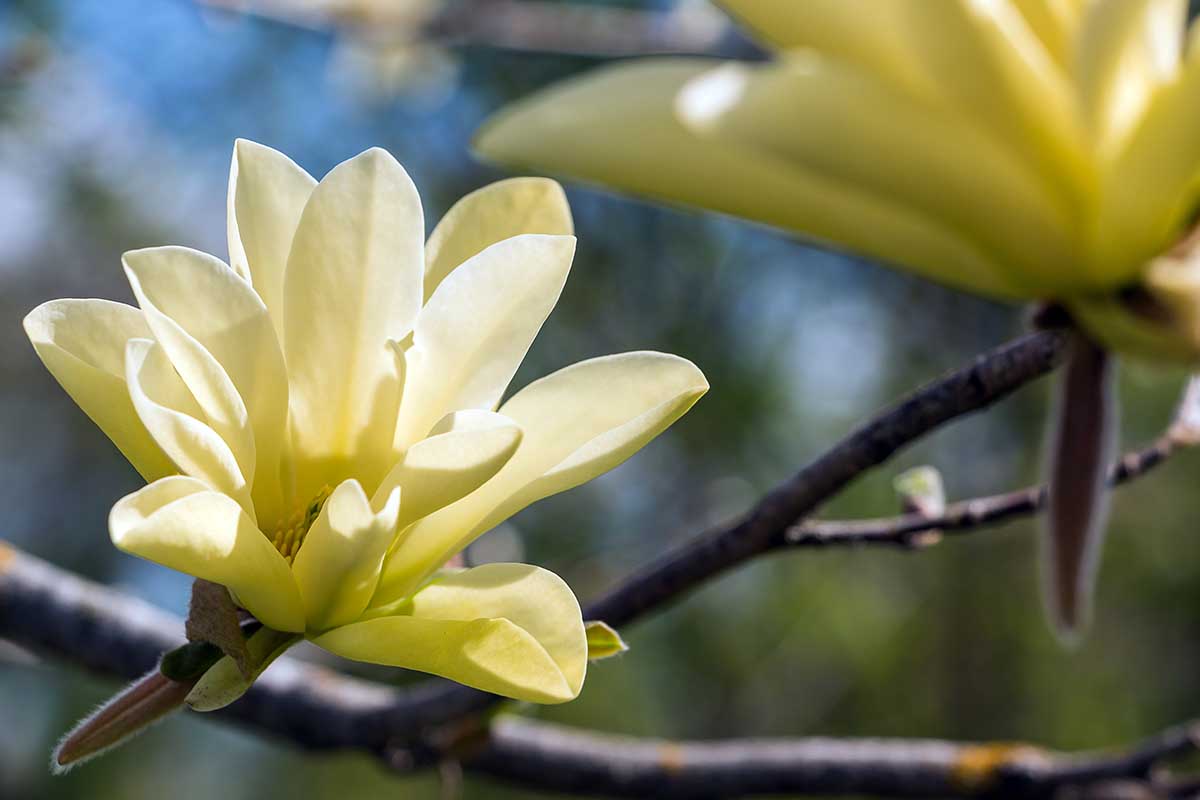
Also known as blue magnolia or cucumber tree, M. acuminata is both massive and is unafraid of a real chill.
It grows indigenously up into the interior of eastern Canada and can tolerate wintertime low temperatures as far north as Zone 3. The term “blue” comes from the fact that the closed buds have a distinct blue hue, but the flowers are yellow and cream.
The downside with this type is that the flowers are fairly petite. If you’ve gotten used to foot-wide flowers, it can feel like a downgrade, but the beautiful blossoms are still several inches across and a pretty creamy yellow.
After the flowers drop, a fruit-like center forms that looks distinctly like a petite cucumber when it’s immature. You can even pickle and eat them if you want, though they don’t taste like cucumbers. They’re far more citrusy.
9. Felix
‘Felix’ (M. x ‘JURmag2’) is incomparable. It has massive, foot-wide, bright magenta blossoms smothering a 20-foot-tall and seven-foot-wide tree.
Some magnolias are a bit less impressive when grown in cooler Zones because they won’t bloom as abundantly, but ‘Felix’ isn’t fazed.
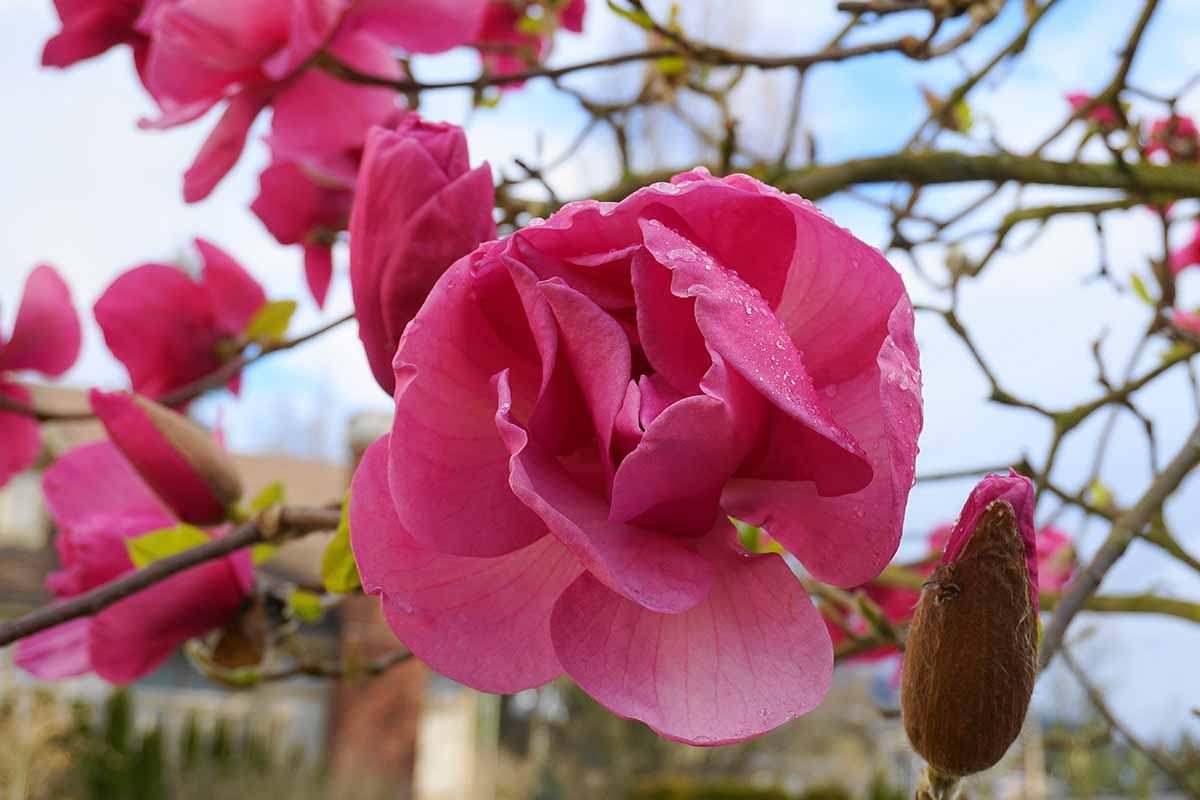
Bred by noted magnolia breeder Mark Jury and named for his father, the blossoms are heavily fragrant, and the tree itself is sturdier than many others.
Do you live in Zones 5 to 9? This cultivar can be challenging to find, but if you do, grab it.
10. Galaxy
This 35-foot-tall hybrid cultivar erupts into a profusion of purplish-pink flowers at the end of bare stems, like a big bang of tepals.

If you love to create a cut flower display in your home, this hybrid is one to have around.
‘Galaxy’ was bred at the US National Arboretum in 1963 using M. liliiflora ‘Nigra’ x M. sprengeri ‘Diva’ to combine the best of both with a dense, pyramidal tree form that blooms late enough to dodge most late frosts.
And it’s a good thing, because you wouldn’t want to miss out on these flowers! They can be up to a foot across, and they have 12 petals, so they’re incredibly striking.
Add ‘Galaxy’ to your garden universe by heading to Nature Hills Nursery to pick up a four- to five-foot tree in a #3 container for your Zone 5 to 9 garden.
11. Genie
Don’t keep this genie in a bottle. ‘Genie’ is a beautiful hybrid in a small package.

The tree tops out around 10 feet tall, dressed up in a robe of deep burgundy, cup-shaped flowers growing at the end of the bare branches. And the blossoms are anything but small, at up to seven inches across.
That’s not the end of the show, though. This is a reliable rebloomer in Zones 5 to 9 that will put up another display in the summer.
Created by breeder Vance Hooper in New Zealand using M. x ‘Black Tulip’ and M. liliiflora ‘Nigra,’ it blooms later in the spring than many other types, so you can escape most of those sneaky late frosts.
Use it in containers or to make a small hedge.
Nature Hills Nursery carries this petite stand-out.
12. Lily
The lily magnolia (M. liliiflora) is native to China and grows as a large shrub or small tree with a symmetrical shape.
It blooms before the leaves emerge with pink, purple, and white goblet-shaped blossoms with seven tepals and a heavenly citrus scent.
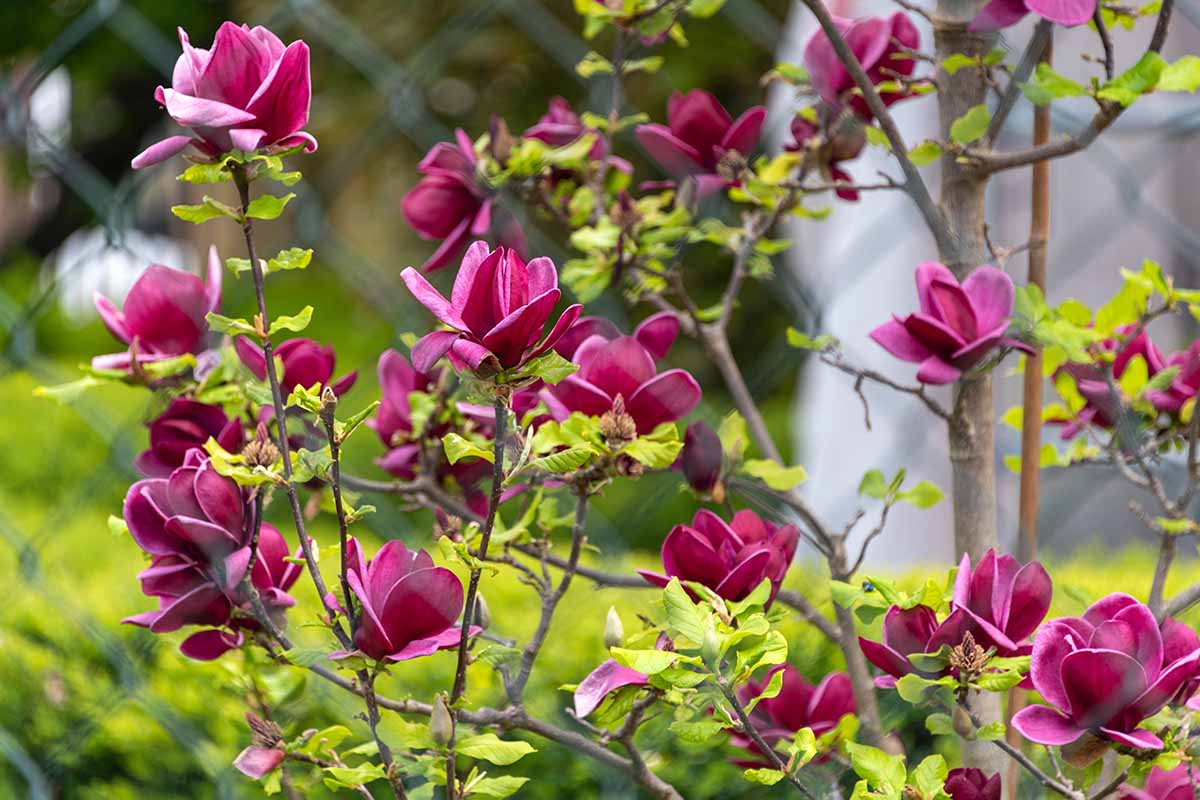
The plant can grow up to 12 by 12 feet in height and spread but it usually stays smaller, so it’s ideal for containers.
It’s not common in North America, but this species is wildly popular in China and Japan. It does well in Zones 5 to 8.
13. Loebner
What do you get when you cross floriferous M. kobus and the star-like blossoms of M. stellata? The lovely Loebner magnolia (M. x loebneri).

It’s a mini tree or large shrub with petite blossoms, but the impact is anything but small.
The six-inch, pink, purple, and white flowers have 15 narrow tepals, and the trees are positively covered in them. They’re also intensely fragrant. These plants are hardy in Zones 5 to 9.
There are lots of exceptional cultivars, including ‘Merrill,’ which was bred by Karl Sax, the third director of Arnold Arboretum at Harvard University from 1946 to 1954.
It’s a fast grower that reaches up to 25 feet or so with pure white flowers that have wider tepals than the species.
Nature Hills Nursery has you covered if ‘Merrill’ sounds like a winner to you. They have three- to four-foot live plants in #3 containers.
‘Leonard Messel’ is another option, with bicolored rosy-purple and white flowers. It’s robust and frost resistant. Snag one in a #3 container from Nature Hills Nursery.
14. Jane
‘Jane’ is an incredibly popular hybrid cultivar that’s vigorous and hardy. It will bloom even when it’s colder than what other magnolias can tolerate, growing in Zones 4 to 8. It can also withstand heat.
In the spring, you’ll be treated to purple-red and white blossoms on plants that stay a petite 15 feet or smaller.
‘Jane’ is a cross between M. liliiflora ‘Reflorescens’ and M. stellata ‘Waterlily,’ another member of the Little Girl series bred at the National Arboretum.
Sound like what you’re looking for? Fast Growing Trees has one- to two-, two- to three-, or three- to four-foot-tall live trees.
15. Kobus
Kobus magnolia (M. kobus) is a large shrub or small tree with multiple stems that is native to Japan.
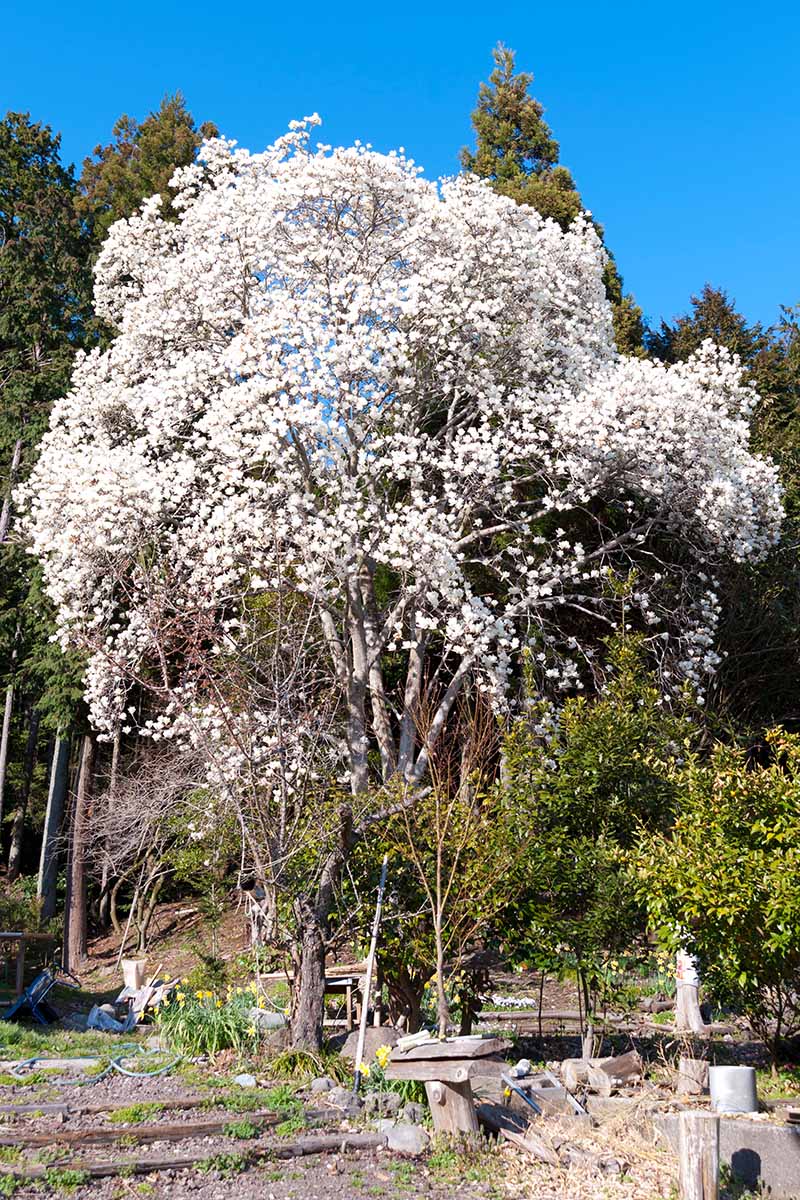
These typically have smaller flowers than some other species, but they produce a ton of them.
The trees look like they’re covered in snow when they’re in bloom. Even when they aren’t blooming, the dark green leaves are extremely attractive.
These plants are slower growers than some other species, which means they aren’t as prone to breakage. They’re happy in Zones 5 to 8.
16. Saucer
A cross between M. denudata and M. liliflora, saucer magnolias (M. x soulangeana) are highly sought after hybrids with many popular cultivars.
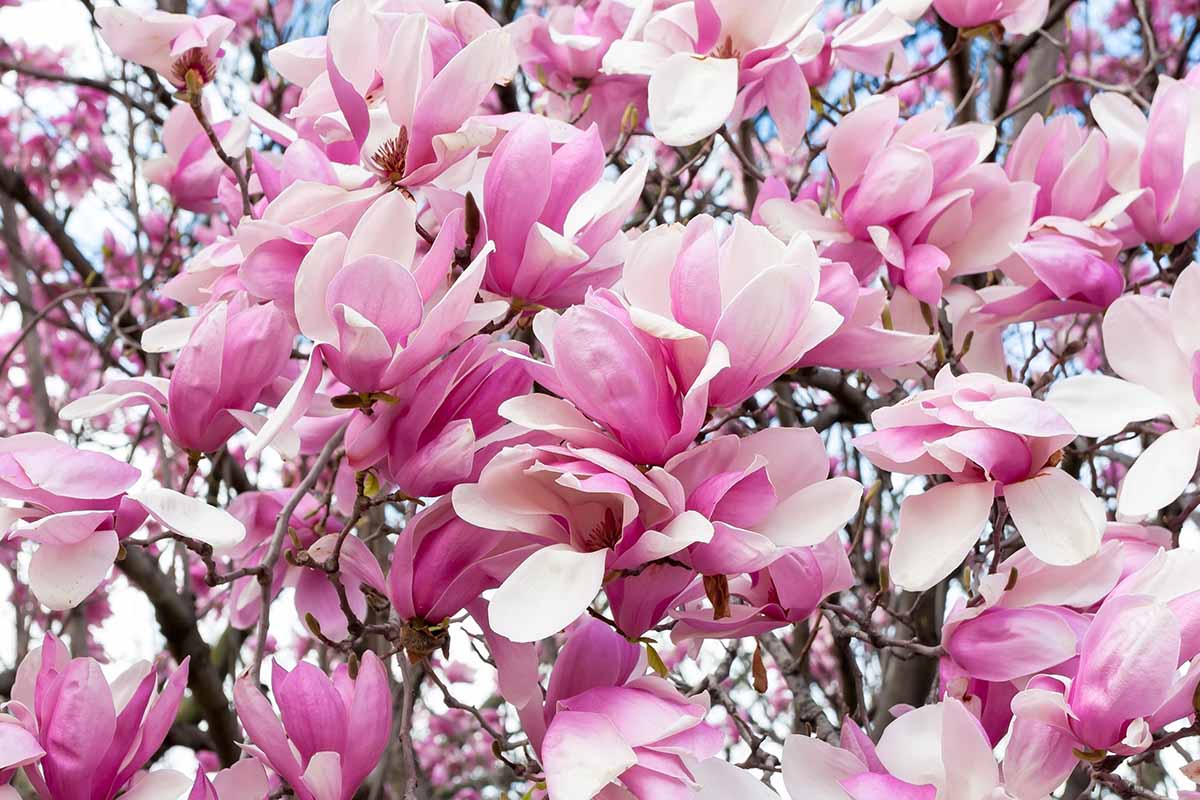
They typically have massive, plate-sized blossoms in a broad spectrum of white, pink, and purple hues.
They’re also fairly cold hardy, good to go in Zones 4 to 8.
If you want to plant the original in your garden, it’s a gorgeous 25-foot shrub or tree that blooms extremely early in the year.
No wonder it’s so popular in warmer areas! It’s also a fast grower, so you don’t have to wait long for the display.
Bring one home from Fast Growing Trees.
‘Alexandrina’ (not Alexandria) was introduced in 1831 by Cels of Paris, and it has been a popular saucer option ever since.
The outside of the flowers is white with a contrasting purple-magenta inside, with the darkest coloring at the base of the petals.
There is a pure-white form of this plant as well, ‘Alexandrina Alba,’ but it’s far less common. Even less common is a form with variegated leaves known as ‘Alexandrina Variegata.’
Make ‘Alexandrina’ yours and bring her home from Nature Hills Nursery.
‘Black Tulip’ is another exceptional option. The six-inch blossoms are a deep reddish-purple that looks different from most other magnolias.
Bare root plants are available from Burpee.
17. Sargentiana
I think M. sargentiana is an unsung wonder of the magnolia world.
These can be downright majestic, completely covered in so many blossoms that you might think the tree just has pink or white leaves for a few weeks out of the year.
Sure, the flowers can’t compete in terms of size with some others, but that doesn’t make them any less striking.
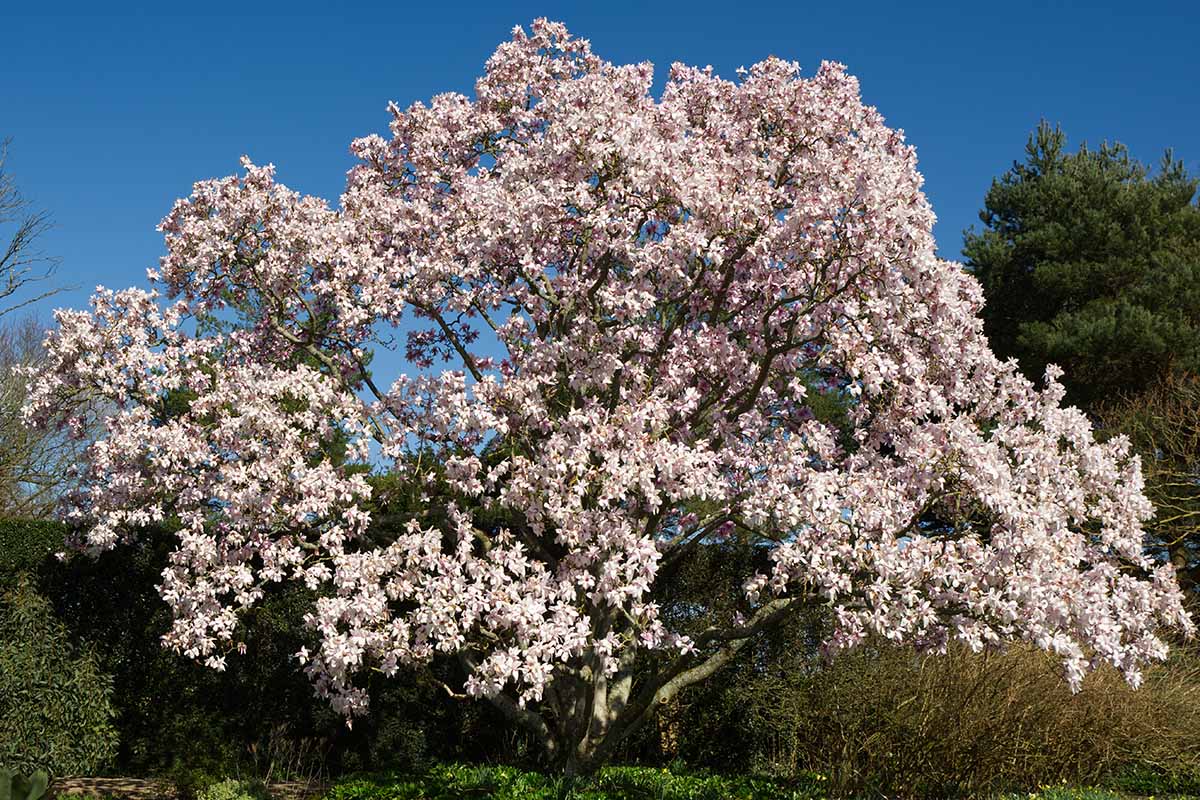
Sadly, this species is not quite as versatile as some of the other options. It needs to be planted in Zones 6 to 9, but gardeners in those regions are in luck.
‘Caerhays Belle’ is an attractive hybrid cross of M. sargentiana and M. sprengeri. It is absolutely covered in salmon pink flowers in the spring.
I prefer to stick to native options, but I’ll make an exception for this Chinese native.
The species can occasionally skip or have a very reduced year in terms of flowering, so you should look for the excellent cultivars and hybrids like ‘Caerhays Belle’ that don’t need to take an occasional break.
18. Southern
Here’s the classic. The one you see in all the iconic movies and TV shows based in the southern US.
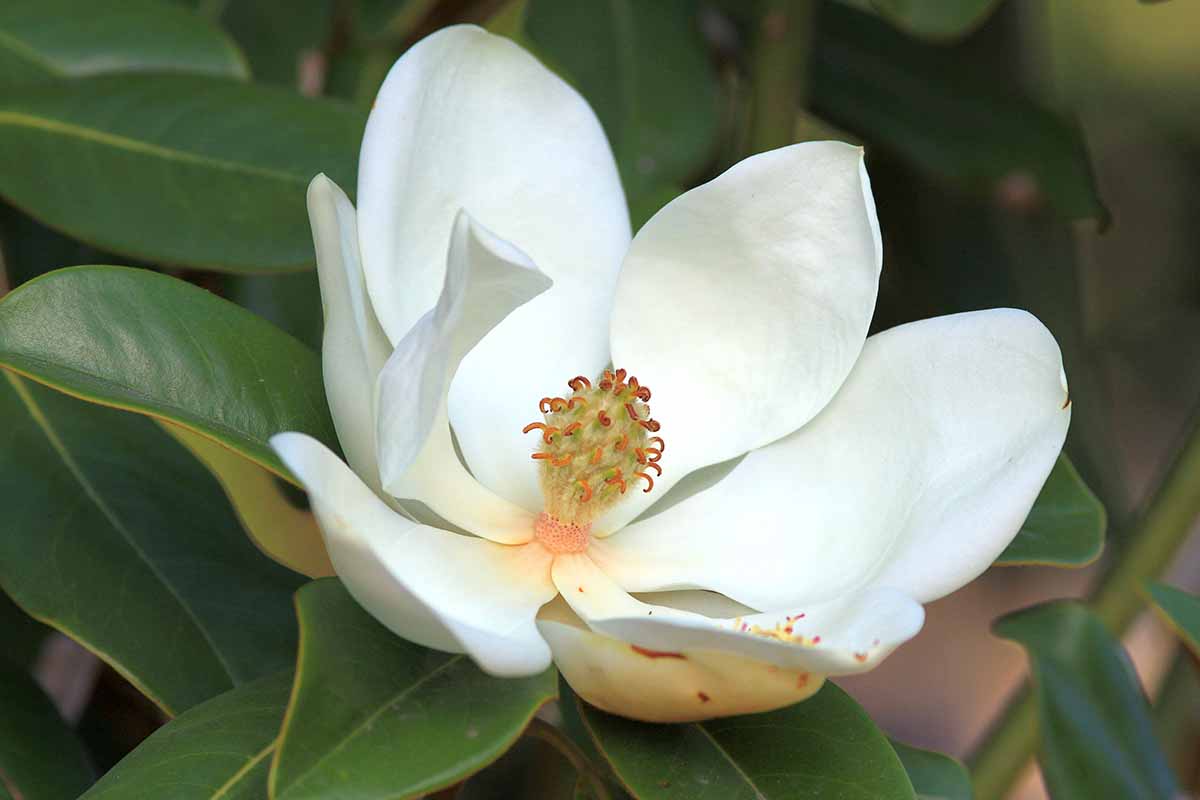
Southern magnolias (M. grandiflora) are some of the most common in gardens in the US.
When you picture that large, flowering tree immortalized in southern literature and movies, this is the species they’re usually talking about.
These trees are native to the south, spanning as far north as Virginia and down into Florida, and from the Atlantic Coast to eastern Texas. They can grow up to 80 feet tall and half as wide, though they will stay smaller in cooler regions.
Most cultivars have large white or cream blossoms and they are evergreen. They’re capable of growing as far north as Zone 6, so don’t assume you have to live in a warm area to grow these plants.
‘Bracken’s Brown Beauty’ is a particularly lovely semi-evergreen cultivar with fragrant white flowers and dark green leaves with a rusty brown underside.
Roy Bracken discovered this beauty in 1968 in a nursery in South Carolina, and while the flowers are about half the size of other cultivars, it makes up for it in sheer volume.
The tree itself has a semi-columnar shape, reaching 50 feet tall and around 20 feet wide.
Fast Growing Trees ships quickly, offers a one-year guarantee, and carries this option in two- to three- and three- to four-foot heights.
‘Little Gem’ is perfect for containers or more restricted spaces. Its only flaw, if you could call it that, is that it can’t grow north of Zone 7. Sorry Kansas and Ohio gardeners, but there are lots of other great options for you.
Bred by Steed’s Nursery in North Carolina in 1966, it has a columnar shape with dense, petite leaves and flowers that emerge and stick around later in the season than those of the species.
Other good options include ‘Edith Bogue,’ with her large, lemony blossoms. She’s waiting for you to bring her home from Fast Growing Trees as well.
If you need something petite, ‘Kay Parris’ is a dwarf that usually stays under 20 feet tall. Nature Hills Nursery has this one available in a tree form in a #2 container.
For a nice cold-hardy option, ‘24 Below’ can survive in areas that get as cold as, you guessed it, -24°F.
19. Star
Star magnolias (M. stellata) are native to Japan and have fairly petite flowers, but they produce lots of them.
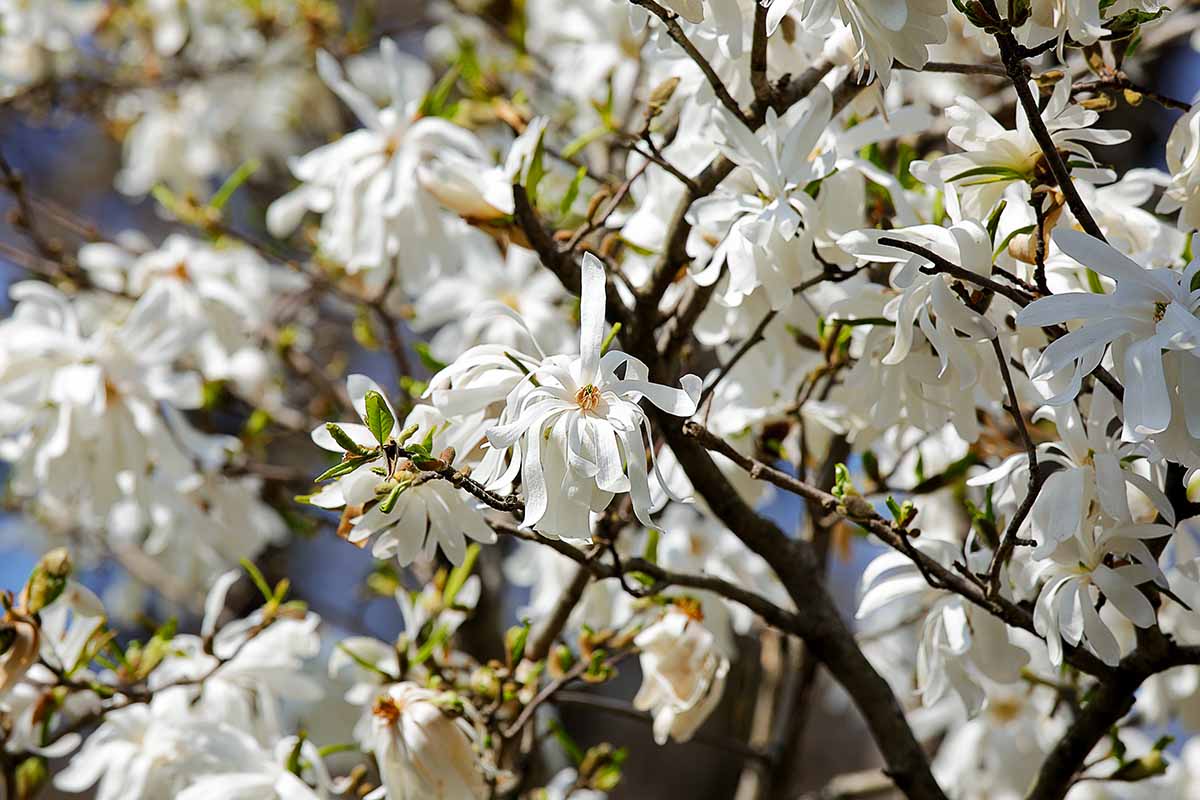
Kind of like looking at the night sky while lying on your back, staring up at these trees you’ll notice that the petals are long and narrow, giving each tepal the appearance of a shooting star bursting across the heavens in the spring.
This shrubby tree is sometimes labeled as a cultivar of Kobushi magnolia (M. kobus), but it’s a separate species. And it’s versatile enough to grow in Zones 4 to 9.
‘Royal Star’ is particularly floriferous and heavily fragrant. Invite this superstar into your space by picking up a plant from Fast Growing Trees.
20. Sunspire
When it comes to magnolias with a columnar growth habit, there aren’t many to choose from.
‘Sunspire’ is a hybrid cross of M. ‘Woodsman’ and M. ‘Elizabeth’ that is just the ticket for anyone who wants a columnar option.
At under 25 feet tall and between six and 10 feet wide, it can fill in those narrow spots or stand tall as an anchor for your garden.
As you might have inferred from the name, the petals are sunny yellow, and the flowers have a tulip-like shape.
Here comes the sun, little darlin’! Bring ‘Sunspire’ home from Nature Hills Nursery in a #2 container if you live in Zones 5 to 8.
21. Sweetbay
Sweetbays (M. virginiana) are a southern classic that can be identified by their dark green leaves with a silvery underside.
Most other magnolias either have the same green color on both sides of the leaves or the underside is a sort of rust color.
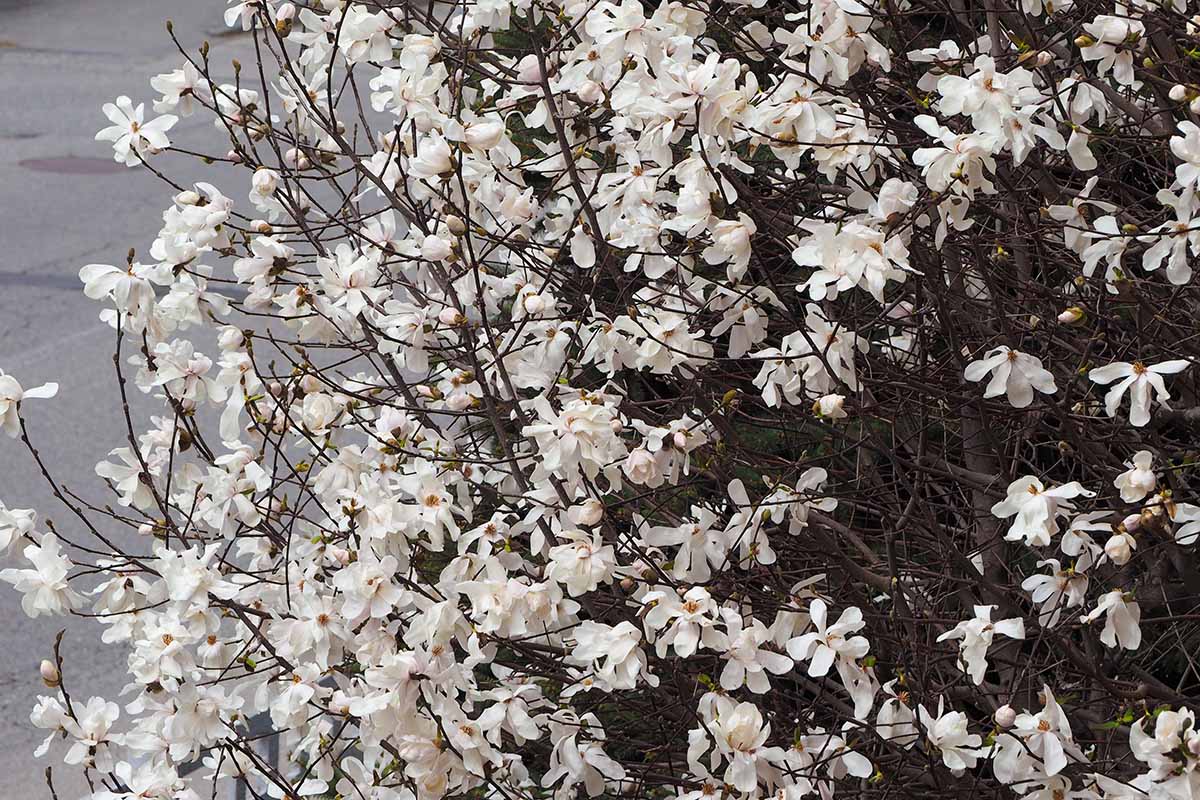
The lemon-scented flowers are about three inches across and pop out in late spring, lasting for several weeks.
The leaves are less leathery than those of the closely-related southern magnolia, and the flowers are slightly smaller. But don’t let that turn you away. Though they’re tiny, they make for a mighty display just in sheer number.
The pure white flowers tend to be deeply cupped, on trees that grow about 50 feet tall and half as wide. This species is hardier than M. grandiflora, thriving as far north as Zone 5.
Taste might be far from your mind when considering a magnolia to grow, but the tepals I’ve tried are some of the best.
They’re light, floral, and slightly citrusy, with a firm enough texture and a mild enough flavor to lend themselves well to a range of dishes. Plus, you get so many of them on each tree!
If you want a shade tree that provides beautiful blossoms and is tough enough to survive even in standing water, this is the answer.
Fast Growing Trees carries two- to three-, three- to four-, and four- to five-foot live trees if the glorious sweetbay sounds like the perfect thing for your garden.
22. Yellow Bird
Imagine a goldfinch perched on the edge of the branch of a tree. Now, imagine thousands of them on the same tree.

‘Yellow Bird’ is an M. acuminata cultivar with bright yellow, tulip-shaped blossoms that emerge later in spring, at the same time as the foliage rather than prior to the leaves.
The benefit of this timing is that the flowers are less likely to be exposed to late-season frosts.
But you might not know the leaves are even there when the tree is covered in those yellow avian flowers!
This is a vigorous grower that tops out at about 40 feet, and it does well in Zones 4 to 8.
Give ‘Yellow Bird’ a home in your garden, no birdseed required, by picking up a six- to 10-inch tree at Amazon.
23. Yulan
Yulan magnolias (M. denudata) are also known as lily or tulip trees, and it’s completely obvious why.
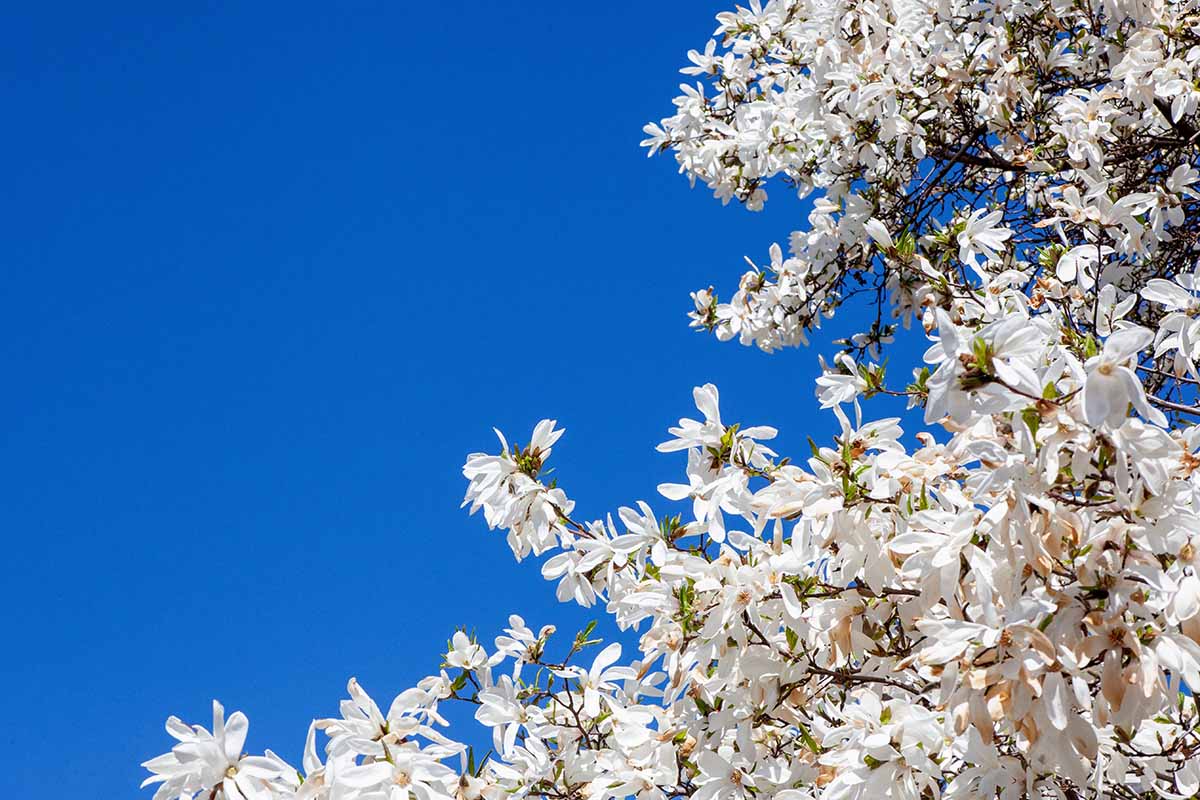
The trees, which are considered to be some of the most beautiful of all magnolias, are covered in pure white tulip-shaped blossoms.
But these shouldn’t be confused with the light green and orange blooms of the tulip poplar (Liriodendron tulipifera), also commonly referred to as tulip tree.
At first glance, you would probably think that the tree has white foliage, that’s how many blossoms there are on the tree.
Even when it’s not in bloom, it has beautiful medium green leaves on an upright, symmetrical tree. It’s also versatile enough to grow in Zones 4 through 9.
It’s a Chinese native that can be a little challenging to find on the market, but there are lots of beloved hybrids bred from it, such as ‘Elizabeth,’ ‘Butterflies,’ and saucer magnolias, so watch for those.
So Many Magnolias, So Little Time
If I had acres and acres of land, I’d grow hundreds of magnolias. The moment the fuzzy little buds start emerging in late winter, I get a little thrill.
It’s only a few weeks until the striking blossoms are blanketing the trees. I can only imagine the joy of seeing hundreds of trees in bloom at once.
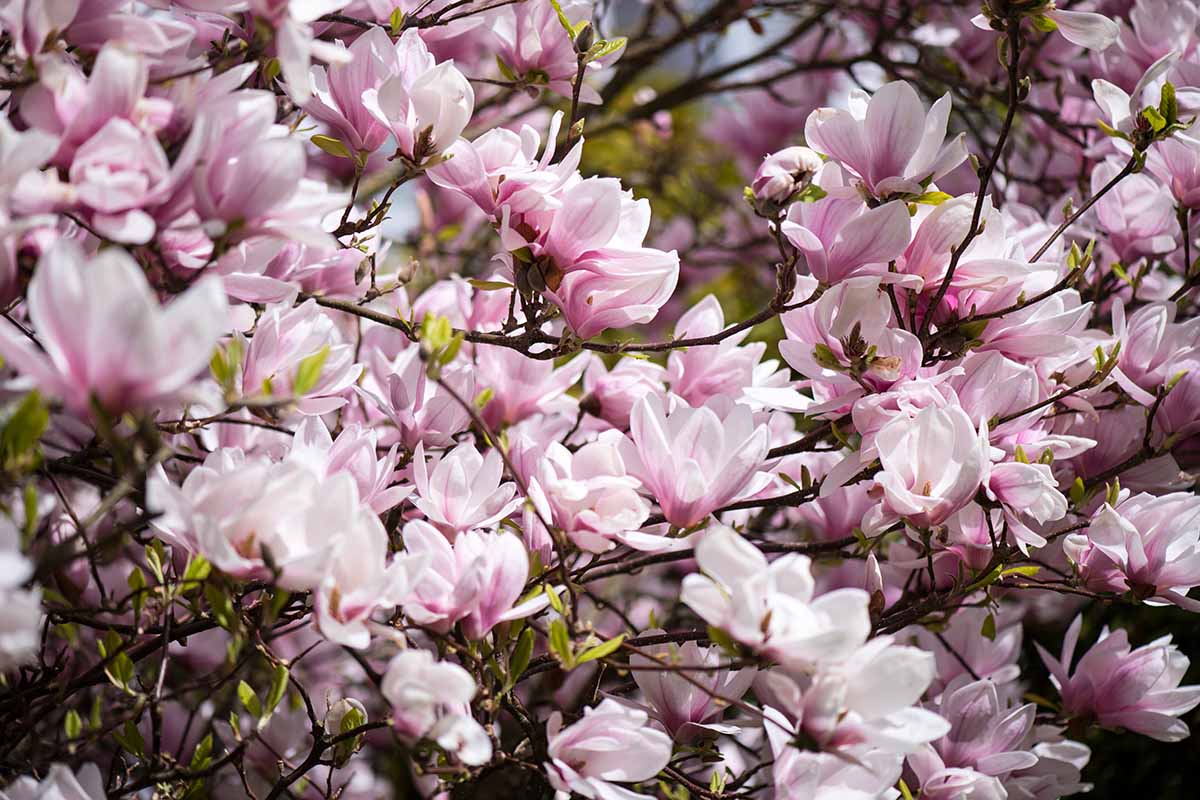
Alas, I’ll have to settle for just a few trees. But knowing about some of the best options out there makes it easier to pick, right?
Which one on this list are you considering? How will you use it in your garden? As a shade tree? A shrub next to your window to let the fragrance into your house? Let us know in the comments.
And if you need a refresher on how to grow magnolias, check out our guide.
Where one tree is good, more are better. If you want to grow some other excellent landscape trees, we have a few guides that can help you on your journey, including:

